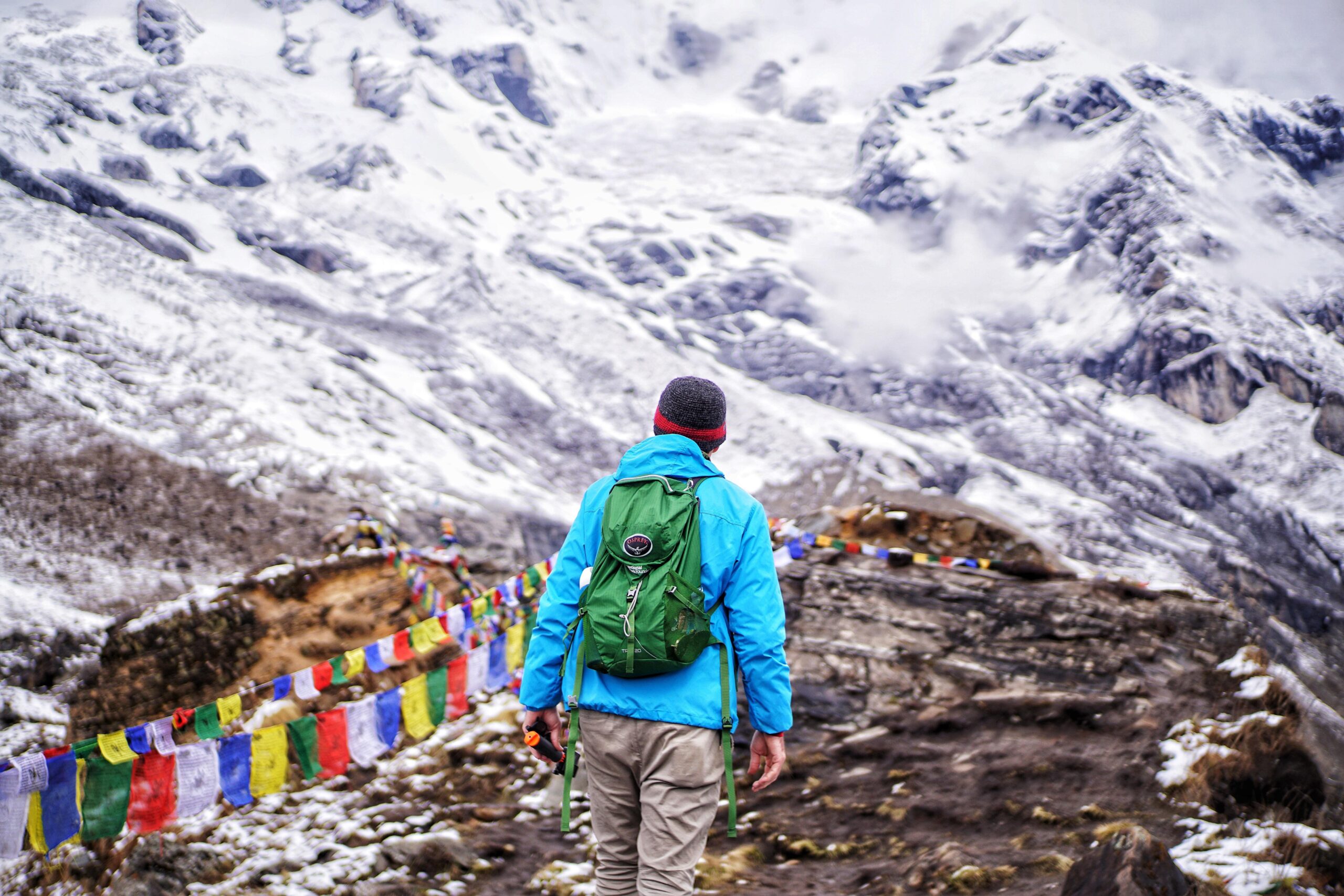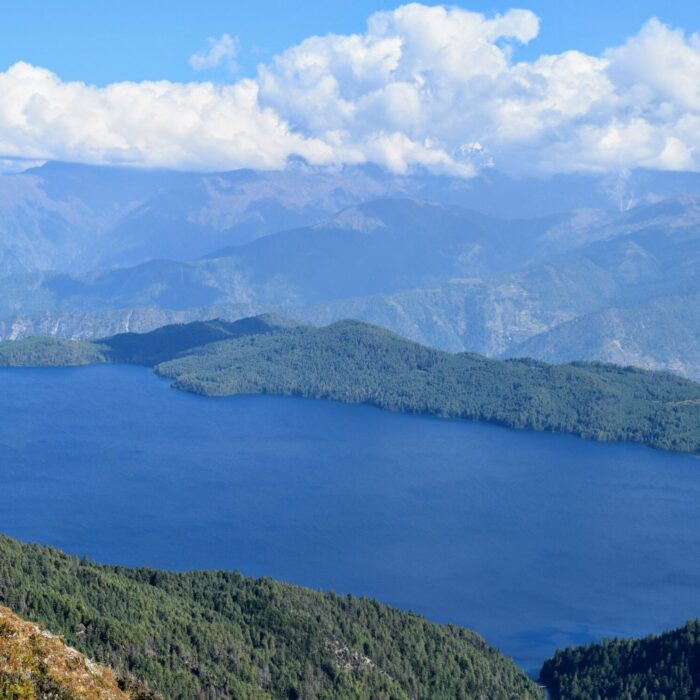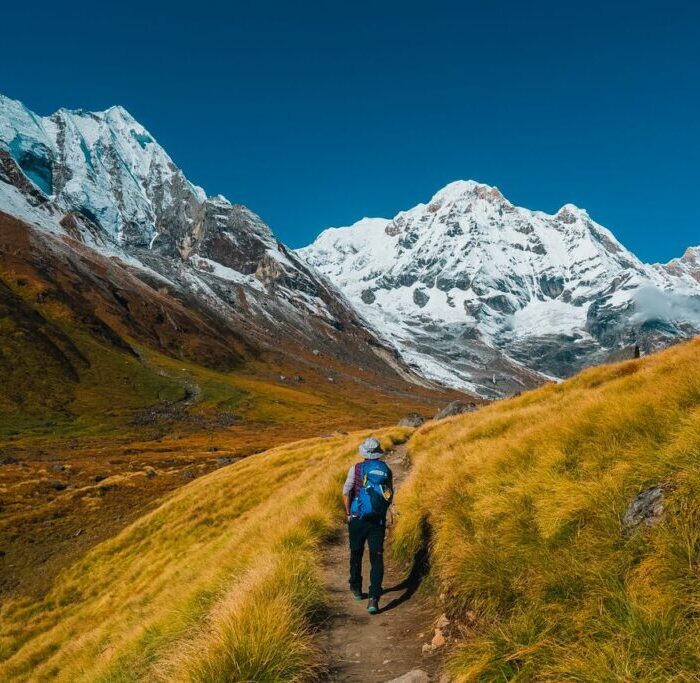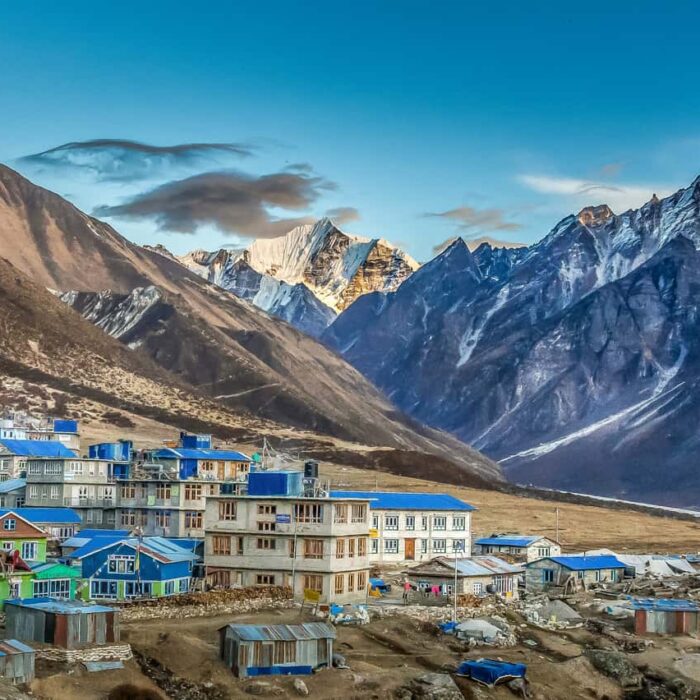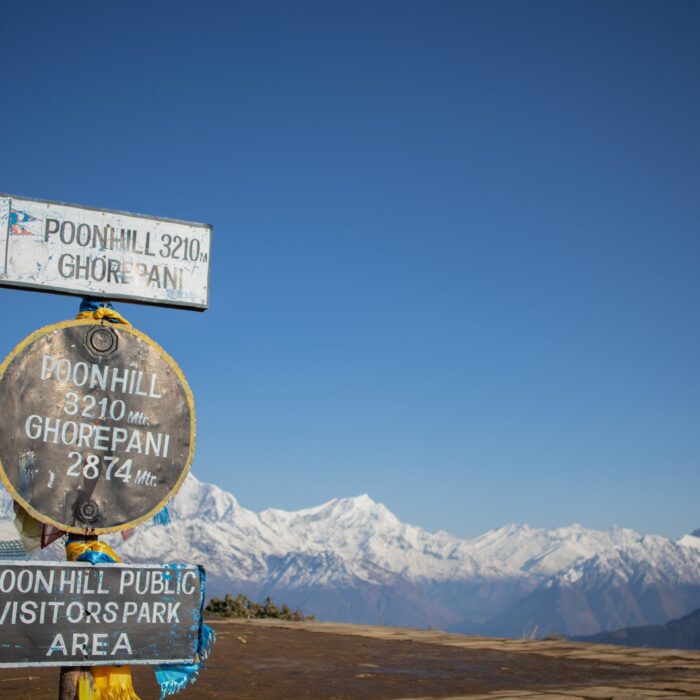The 6-day Annapurna Base Camp Trek is perfect for those with limited time who still want to experience the great scenery and unique culture of the Gurung people and villages. Also called the Annapurna Sanctuary Trek, this trek offers close range views of great mountains like Hiunchuli, Machapuchhre (Fishtail), and Annapurna South peaks.
Spring is the best time for this Annapurna base camp 6-day trek when Rhododendron forests bloom in red, pink, and white. But you can do this trek any time of the year. Along the trail, you’ll see peaks like Mt. Dhaulagiri, Mt. Annapurna I, Mt. Manaslu, and others.
You’ll also spot Tharpu Chuli, Singu Chuli, Hiunchuli, and South Annapurna peaks. The influence of Tibetan Buddhism is clear with stupas (Buddhist stone monuments) and prayer flags along the way. Expect to see yaks, bamboo forests, and traditional Tibetan-style designs in the villages.
Your journey starts in Kathmandu, then you’ll drive to Pokhara and Nayapul where the trek begins. Passing by the Modi Khola River and rice fields, you’ll reach Chomrong and Ghandruk. You’ll also have time to go through Ghandruk’s mountain town and learn about its culture.
With over 30 years of experience, Alliance Treks makes sure that all permits, places to stay, and meals are taken care of during the trek.
Accommodations
During your trek, you’ll stay in 3-star hotels in Kathmandu. As you trek, you’ll sleep in lodges and tea houses along the way. Some of these places have bathrooms, especially at lower spots. But as you climb higher, the places to stay get simpler, with just the basics.
Even though the places may vary, each one offers a special feel. Whether it’s a comfy hotel or a cozy tea house, we make sure that you have a good place to rest during your trek.
Meals
In Kathmandu, your hotel gives you breakfast. But during the 6-day Annapurna base camp trek, we’ll provide all your meals (breakfast, lunch, and dinner). In these areas, people eat a lot of potatoes, oats, Sherpa stew, and Tibetan bread.
Did you know? Sherpas started growing potatoes in the early 90s when they first got seeds for them. At higher places, you won’t find a big variety of food. Mostly, you’ll see dishes made from potatoes. Potatoes are full of carbohydrates, which give you lots of energy. It is also perfect for when you’re up in the mountains.
So, get ready to enjoy some tasty, filling meals along the way, keeping you fueled up for your trek.
Transport
During the day trip and for getting to and from the airport and hotel, we’ll use a private car just for you. It’s fair and comfortable. But during the trek, we switch to public transportation or local buses. These are the usual ways people get around in those areas. They’re safe and let you feel the local life while traveling. So, you’ll have the best of both worlds. The ease of a private car when you’re not on the trek, and the real feel of traveling like a local when you hit the trails.
This trek can be tough sometimes, with about 6-7 hours of walking each day. You don’t have to be an expert hiker to do it, but if you’ve done some hiking before, then that’s a bonus. We’ve seen all kinds of people finish this trek, no matter their age, shape, or size. The main challenge is dealing with height, which can make you feel pretty sick.
Before you come to Nepal, it’s helpful to get in better shape and practice breathing deeply. This can make it easier for your body to handle the height.
So, while the trek can be hard, anyone can do it with a bit of preparation and determination. Just be ready for the height and keep pushing forward.
If you are also further interested in other Annapurna base camp treks or other trek programs then you can check our
Please check our trek equipment list. This list will be a guide for you if you plan to trek in Nepal. Similarly, you can check our AMC (Acute Mountain Sickness) which can be a good guide for you to learn more about getting ill at high heights in Nepal. Also, if you want to do a Peak climb in Nepal then please check the climbing equipment list that is a must while going on the Peak climb. Likewise, we suggest you check the updated TIMS card rule as there have been some new changes in Nepal.
Booking is Open for 2024 / 2025
Are you planning to do a trek or tour in 2024? If so, then in our Best Deals part, you can find the ideal information on the best price for the trek cost. Furthermore, book plans as soon as possible.
Contact us or Send a message or call us at
WhatsApp / Viber / Mobile: + 977 – 9851 022814, + 977 – 9841 451681
We are available 24/7
For further information, Contact us.
Itinerary
Day 1: Drive from Pokhara Siwai and trek to Chomrong (2,210m) (Duration: 5-6 hours.
We start by driving for about 3 hours from Pokhara to Kimche, passing through Nayapul and Birethanti, which is where they check tourists. Then, we begin walking to Kimche, going through pretty villages like Syauli Bazaar and Chane. We cross the Khumnu Khola River before reaching the Gurung town of Siwai.
The next part of our journey is a trek to Chomrong village, which is the last village before we get to Annapurna Base Camp. We start by walking downhill from Ghandruk to the Kyuri Khola River. Then, we follow the trail to Kimrung Danda. Along the way, you’ll see terraced farmlands and reach Gurung. From there, it’s an easy trek to Chomrong, where we’ll spend the night at a guesthouse.
Day 2: Trek from Chomrong to Himalaya (2,840m) Duration: 5-6 hours.
Today, the path goes down to the Chomrong Khola River and then goes up to Khuldighar, which is at 2,380m altitude. There used to be a checkpoint there for the Annapurna Conservation Area. As we climb higher, you’ll see fewer trees and more dry land. We’ll keep following the path on the west side of the river, and before we reach our stop for the day, we’ll walk through bamboo and rhododendron forests. Finally, we’ll get to the Himalaya, which are at 2,840m altitude, where we’ll spend the night at a guesthouse.
Day 3: Trek from Himalaya to ABC (4,120m) Duration: 5-6 hours.
Today, we’ll trek along a snowy trail to reach Annapurna Base Camp (ABC). Along the way, we’ll pass by Hinku Cave and Deurali, and then we’ll go past Machapuchare Base Camp before reaching ABC. Once we’re at ABC, get ready for some jaw-dropping views! You’ll see amazing mountains like Annapurna I, Khangsar Kang, Gangapurna, Annapurna III, and Machapuchare. It’s like having a giant mountain painting right in front of you! At ABC, there are cozy teahouses where we can relax and enjoy the breathtaking scenery. We’ll spend the night here, surrounded by these majestic peaks.
Day 4: Trek from ABC to Bamboo (2,310m) Duration: 5-6 hours.
We’ll take the same path back down, descending about 1,700m until we reach the Modi Khola riverbank. Then, we’ll head to Bamboo, which is at 2,345m altitude, where we’ll spend the night in a cozy teahouse.
Day 5: Trek from Bamboo to Jhinu Danda (Hot spring (1,750m) Duration: 6-7 hours.
After we leave Bamboo in the morning, we’ll have a little uphill walk to reach Sinuwa Village at 2320m. Then, we’ll continue to Chomrong. After a quick break in Chomrong, we’ll go uphill again before finally going downhill to Jhinu Danda Village. This is a great opportunity to soothe your tired muscles in the hot spring near the Modi River. We’ll spend the night here.
Day 6: Trek from Jhinu Danda to Nayapul and drive to Pokhara (827m) Duration: 5-6 hours.
Today is our last day on the trail. We’ll start by leaving Jhinu Danda Village and walking along the path next to the Modi Khola River. This will take us about 4 to 5 hours until we get to Birethanti Village. From there, we’ll keep going to Nayapul before we hop back in the car and drive back to Pokhara.
Include / Exclude
The above cost includes:-
- Pokhara/Nayapul & Nayapul/Pokhara private transfer
- Nayapool/Kimchi on shared Jeep
- 6 Days Annapurna Base Camp trek using local lodges as available (Basic and possibility to share dormitory)
- All meals during the trek as mentioned in itinerary details (Breakfast, Lunch, Dinner & tea/Coffee in a cup during breakfast)
- One guide & one porter from Pokhara for groups of 2 pax & above (porter ratio of 2 travelers = 1 porter) however if you are one person trekking then we will provide you one porter cum guide who will also carry 12 Kgs of your trek bag
- Annapurna Conservation Area Permit Fee (ACAP)
- TIMS fee as applicable
- Duffel bag, Sleeping bag & down jacket if required (Need to return at the end of the trek)
- Government taxes as applicable
The above cost excludes:-
- Hot water (Boiled drinking water), Hot shower & Battery charges
- Personal expenses & Gratitude
- Arrangements in Pokhara and any other services not mentioned in the cost include section
Frequently Asked Questions (FAQ)
Q1. What is the Annapurna Base Camp Trek?
The Annapurna Base Camp Trek is a popular trekking route in Nepal that takes you to the base camp of Mount Annapurna, one of the highest peaks in the world. It offers breathtaking views of the Annapurna range and allows you to experience the unique culture and hospitality of the local communities.
Q2. How long is the Annapurna Base Camp Trek?
The duration of the Annapurna Base Camp Trek can vary depending on the specific itinerary and trekking agency. Typically, it takes around 5-14 days to complete the trek. This includes the trekking days and acclimatization/rest days.
Q3. What is the best time to do the Annapurna Base Camp Trek?
The best time to do the Annapurna Base Camp Trek is during the spring (March to May) and autumn (September to November) seasons. These months offer pleasant weather, clear skies, and favorable trekking conditions. However, the trek can be done throughout the year, except during the monsoon season (June to August) when the trail can be muddy and prone to landslides.
Q4. Do I need a permit for the Annapurna Base Camp Trek?
Yes, you will need a TIMS (Trekkers’ Information Management System) card and an Annapurna Conservation Area Permit (ACAP) to do the Annapurna Base Camp Trek. These permits can be obtained in Kathmandu or Pokhara.
Q5. What is the difficulty level of the Annapurna Base Camp Trek?
The Annapurna Base Camp Trek is considered to be a moderately challenging trek. It involves walking for several hours each day on varied terrain, including uphill and downhill sections. A reasonable level of fitness and prior trekking experience are recommended.
Q6. What is the maximum altitude reached during the Annapurna Base Camp Trek?
The maximum altitude reached during the Annapurna Base Camp Trek is Annapurna Base Camp, which stands at an elevation of 4,130 meters (13,550 feet).
Q7. What are the accommodation and food options during the trek?
Accommodation during the Annapurna Base Camp Trek is usually in basic teahouses or lodges along the trail. These provide simple rooms with shared facilities. As for food, you can expect to find a variety of Nepali and international dishes, including dal Bhat (rice and lentil soup), momo (dumplings), and noodles.
Q8. Is a guide necessary for the Annapurna Base Camp Trek?
While it is not mandatory to hire a guide for the Annapurna Base Camp Trek, it is highly recommended, especially if you are not familiar with the area or have limited trekking experience. A guide can provide valuable insights, help with navigation, and ensure your safety throughout the trek.
Q9. What should I pack for the Annapurna Base Camp Trek?
Some essential items to pack for the Annapurna Base Camp Trek include sturdy trekking shoes, warm clothing, a good-quality backpack, a sleeping bag, a water bottle, a hat, sunscreen, insect repellent, and a first aid kit.
Q10. Can I combine the Annapurna Base Camp Trek with other treks in the region?
Yes, it is possible to combine the Annapurna Base Camp Trek with other treks in the Annapurna region, such as the Poon Hill Trek or the Mardi Himal Trek. This allows you to explore more of the stunning landscapes and cultural diversity of the area.

